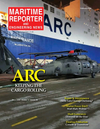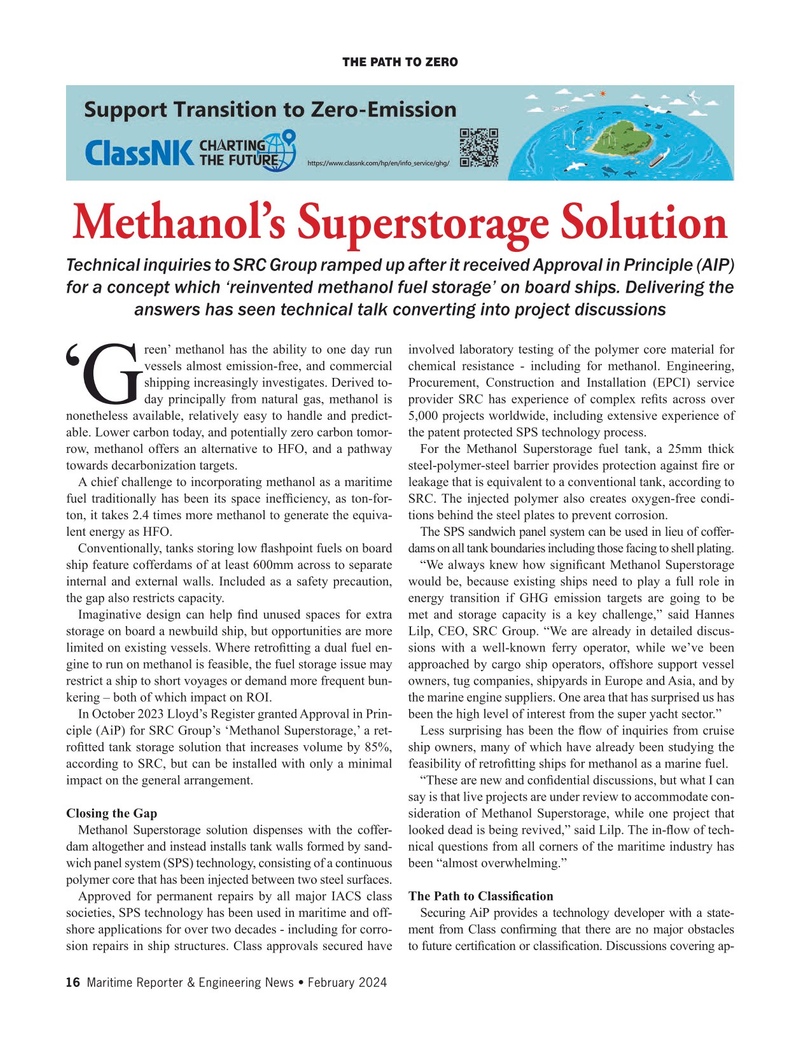
Page 16: of Maritime Reporter Magazine (February 2024)
Read this page in Pdf, Flash or Html5 edition of February 2024 Maritime Reporter Magazine
THE PATH TO ZERO
Methanol’s Superstorage Solution
Technical inquiries to SRC Group ramped up after it received Approval in Principle (AIP) for a concept which ‘reinvented methanol fuel storage’ on board ships. Delivering the answers has seen technical talk converting into project discussions reen’ methanol has the ability to one day run involved laboratory testing of the polymer core material for vessels almost emission-free, and commercial chemical resistance - including for methanol. Engineering, shipping increasingly investigates. Derived to- Procurement, Construction and Installation (EPCI) service ‘G day principally from natural gas, methanol is provider SRC has experience of complex re? ts across over nonetheless available, relatively easy to handle and predict- 5,000 projects worldwide, including extensive experience of able. Lower carbon today, and potentially zero carbon tomor- the patent protected SPS technology process. row, methanol offers an alternative to HFO, and a pathway For the Methanol Superstorage fuel tank, a 25mm thick towards decarbonization targets. steel-polymer-steel barrier provides protection against ? re or
A chief challenge to incorporating methanol as a maritime leakage that is equivalent to a conventional tank, according to fuel traditionally has been its space inef? ciency, as ton-for- SRC. The injected polymer also creates oxygen-free condi- ton, it takes 2.4 times more methanol to generate the equiva- tions behind the steel plates to prevent corrosion. lent energy as HFO. The SPS sandwich panel system can be used in lieu of coffer-
Conventionally, tanks storing low ? ashpoint fuels on board dams on all tank boundaries including those facing to shell plating. ship feature cofferdams of at least 600mm across to separate “We always knew how signi? cant Methanol Superstorage internal and external walls. Included as a safety precaution, would be, because existing ships need to play a full role in the gap also restricts capacity. energy transition if GHG emission targets are going to be
Imaginative design can help ? nd unused spaces for extra met and storage capacity is a key challenge,” said Hannes storage on board a newbuild ship, but opportunities are more Lilp, CEO, SRC Group. “We are already in detailed discus- limited on existing vessels. Where retro? tting a dual fuel en- sions with a well-known ferry operator, while we’ve been gine to run on methanol is feasible, the fuel storage issue may approached by cargo ship operators, offshore support vessel restrict a ship to short voyages or demand more frequent bun- owners, tug companies, shipyards in Europe and Asia, and by kering – both of which impact on ROI. the marine engine suppliers. One area that has surprised us has
In October 2023 Lloyd’s Register granted Approval in Prin- been the high level of interest from the super yacht sector.” ciple (AiP) for SRC Group’s ‘Methanol Superstorage,’ a ret- Less surprising has been the ? ow of inquiries from cruise ro? tted tank storage solution that increases volume by 85%, ship owners, many of which have already been studying the according to SRC, but can be installed with only a minimal feasibility of retro? tting ships for methanol as a marine fuel. impact on the general arrangement. “These are new and con? dential discussions, but what I can say is that live projects are under review to accommodate con-
Closing the Gap sideration of Methanol Superstorage, while one project that
Methanol Superstorage solution dispenses with the coffer- looked dead is being revived,” said Lilp. The in-? ow of tech- dam altogether and instead installs tank walls formed by sand- nical questions from all corners of the maritime industry has wich panel system (SPS) technology, consisting of a continuous been “almost overwhelming.” polymer core that has been injected between two steel surfaces.
Approved for permanent repairs by all major IACS class The Path to Classi? cation societies, SPS technology has been used in maritime and off- Securing AiP provides a technology developer with a state- shore applications for over two decades - including for corro- ment from Class con? rming that there are no major obstacles sion repairs in ship structures. Class approvals secured have to future certi? cation or classi? cation. Discussions covering ap- 16 Maritime Reporter & Engineering News • February 2024
MR #2 (1-17).indd 16 2/6/2024 12:36:28 PM

 15
15

 17
17
